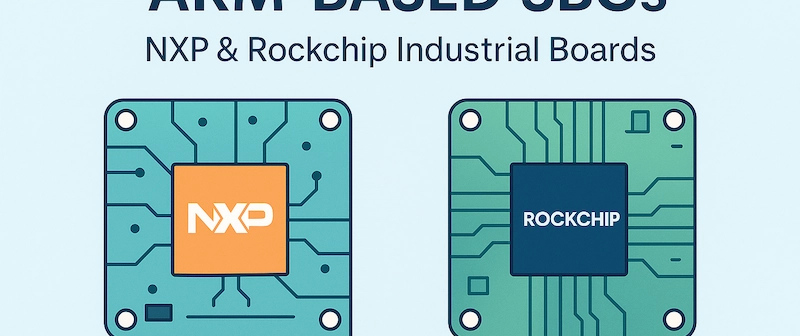Rockchip vs NXP: How to Choose the Right Embedded SoC for Your Product
A practical guide for engineers choosing between Rockchip and NXP SoCs. Learn the key differences in performance, AI capabilities, BSP support, and long-term supply for industrial Android or Linux systems.

Introduction
Selecting the right System on Chip (SoC) is one of the most important decisions a product development team can make.
Whether you’re building an industrial panel PC, an AI-powered gateway, or a smart HMI, the choice between Rockchip and NXP is likely to come up.
These two SoC families dominate many embedded markets — but they take very different approaches.
This article provides a concise, field-tested comparison to help hardware and software teams make informed decisions.
⚙️ Architecture Overview
| Feature | Rockchip (e.g. RK3566 / RK3588) | NXP (e.g. i.MX8M Mini / Plus) |
|---|---|---|
| CPU Cores | Quad-core / Octa-core Cortex-A55/A76 | Quad-core Cortex-A53 |
| GPU | Mali-G52 / Mali-G610 | GC7000L / Vivante GPUs |
| NPU / AI Acceleration | Yes (0.8 – 6 TOPS) | Yes (i.MX8M Plus only) |
| Video Codec | 4K@60 fps H.264/H.265 | Limited to 1080p |
| Multimedia | Advanced, multi-display | More conservative |
| Industrial Focus | Consumer + embedded | Automotive + industrial |
💡 When to Choose Rockchip
Rockchip SoCs are widely used in Android-based embedded systems such as smart displays, media players, and human-machine interfaces (HMIs).
✅ Pros
- High performance per dollar — RK3566 and RK3588 deliver strong benchmarks
- Excellent multimedia support (multi-display, 4K video output)
- Integrated NPU for on-device AI inference
- Robust Android BSP support
⚠️ Cons
- Limited official English documentation
- Shorter industrial lifecycle compared to NXP
🛡️ When to Choose NXP
NXP SoCs are preferred for industrial, medical, and automotive embedded systems where reliability and certification matter.
✅ Pros
- Long-term availability (10–15 years guaranteed)
- Excellent Yocto BSP and mainline Linux support
- Rich industrial interfaces (CAN, TSN Ethernet, PCIe, SPI)
⚠️ Cons
- Lower graphical performance
- No AI acceleration except on i.MX8M Plus
- Higher BOM cost for equivalent compute
📈 Market and Ecosystem
| Aspect | Rockchip | NXP |
|---|---|---|
| Main Markets | Smart devices, multimedia HMIs, Android panels | Industrial, automotive, and medical |
| Ecosystem Strength | Large ODM base in Asia | Strong OEM relationships in EU/US |
| Development Tools | Android Studio + SDK | Yocto, CodeWarrior, MCUXpresso |
| Community | Open, fast-evolving | Mature, documentation-rich |
👉 For a deeper engineering breakdown, visit
Rockchip vs NXP – A Deep Dive for Product Teams (external resource link).
🧪 Developer Experience
| Feature | Rockchip | NXP |
|---|---|---|
| Android Support | Excellent | Limited |
| Linux Kernel | 4.19–5.10 (vendor BSP) | Often mainline Yocto |
| Documentation | Community + Chinese wiki | Industrial-grade documentation |
| SDK Complexity | Medium | High (Yocto-based) |
| Bootloaders | U-Boot, Android A/B | U-Boot (industrial variant) |
Rockchip makes it easy to prototype fast, while NXP focuses on long-term maintainability.
🧭 Final Decision: How to Choose
| Your Focus | Recommended SoC |
|---|---|
| Multimedia / 4K / Android | Rockchip RK3566 / RK3588 |
| Industrial / Automotive | NXP i.MX8M Mini / Plus |
| AI Gateway | Rockchip ( with NPU ) or NXP i.MX8M Plus |
| Cost-Sensitive Design | Rockchip |
| Longevity-Critical Design | NXP |
🔍 Bonus: Real-World Evaluation Tips
- Test the BSP early — Can it boot, display, and run your GUI out of the box?
- Verify AI compatibility — Check TensorFlow Lite / ONNX model support.
- Measure thermal behavior — NXP generally runs cooler; Rockchip may need heatsinking.
- Assess vendor responsiveness — A responsive SDK/BSP team saves months.
📚 Additional Resources
- NXP i.MX8M Product Family Overview
- Rockchip RK3566 Datasheet (via CN vendors, unofficial)
- Understanding NPU Acceleration in Embedded Systems – Edge AI Fundamentals
- Dev.to – Rockchip vs NXP Deep Dive
Conclusion
Choosing between Rockchip and NXP isn’t just about specs — it’s about aligning product priorities with platform strengths.
- Choose Rockchip for cost-effective, multimedia-rich Android systems.
- Choose NXP for long-term, safety-critical industrial deployments.
Both ecosystems continue to evolve, but your choice should reflect project goals, support needs, and market lifecycle.
⚙️ The right SoC is not just a chip — it’s the foundation of your product’s success.